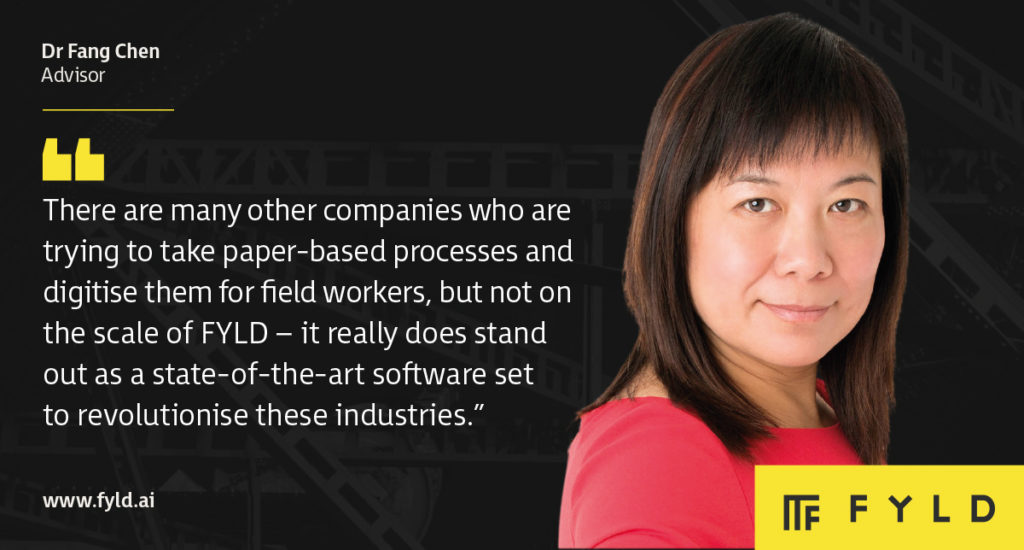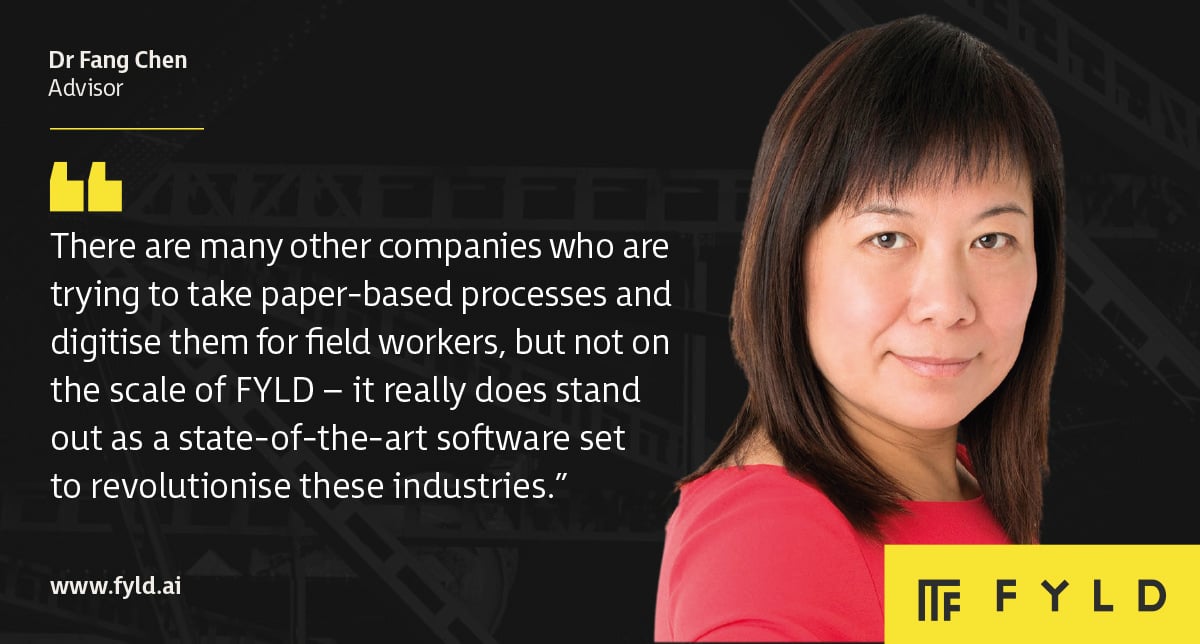Global leader in AI innovations appointed to FYLD’s advisory board

According to recent reports1, the global artificial intelligence (AI) market is expected to grow from $40 billion in 2020 to $51 billion in 2021, and furthermore, it could reach $171 billion in 2025 at a compound annual growth rate (CAGR) of 35%. For Dr Fang Chen, the executive director of data science and distinguished professor at the University of Technology Sydney (UTS), this news is not surprising.
For more than two decades, Fang has been working on some of the world’s most forward-thinking and pioneering projects that use data science to influence evidence-based decision making across industries and government. She has worked on high profile and award-winning research and R&D projects that harness the power of AI technology to transform the world in which we live and work.
She was recently appointed to FYLD’s advisory board, and we are thrilled to have her extensive expertise and tech know-how benefit our team.
We caught up with Fang to find out more…
Q: Welcome to the FYLD team! Can you tell us a little about your role as an advisory board member at FYLD?
A: I’ll be working with the FYLD team to further develop the product strategy around the AI related features and functions. This will then lead to us developing a plan to advance AI functionality within the platform, and embed this into the current and future product.
I’ll also be responsible alongside my fellow board members for broadly looking into the horizon to plan how the company will develop and scale-up for future growth. I’ll bring my learnings and experiences of working in academia, industry and government to support this.
Q: You’ve had a very fulfilling and rewarding career, what made FYLD an interesting company to get involved with?
A: The sectors in which FYLD can be adopted rely on field workers and they typically are very traditional sectors – think oil and gas, water, construction, transport. They also pose high risk for the field workers operating in these harsh industrial environments day-to-day. That means that these sectors are in need of digital transformation to herald a new level of efficiency, productivity and safety. My first impression looking at FYLD’s functionality and features is that this type of product is fit for purpose for the market, and can deliver significant benefits.
There are many other companies who are trying to take paper-based processes and digitise them, but not on the scale of FYLD – it really does stand out as a state-of-the-art software set to revolutionise these industries.
Q: Can you tell us a bit more about your background, how your career developed over the years?
A: Well around 20 years ago I got a PhD in speech recognition and natural language processing – both highly relevant advances for FYLD today. Around that time, I worked as the Dean of Faculty of Electronic and Information Engineering and Director of Institute of information Science at the Beijing Jiaotong University in China.
In 1999, I moved from academia into industry and joined the major software corporation, Intel, where I was responsible for the strategy and planning behind the company’s technology roadmap. Following that, I joined Motorola as Lab Manager and Principal Researcher. In this role, I led the use of speech and language generation in the Motorola China, and established strategic plans and roadmaps for the lab to further develop this innovative technology. I also held the role of Chair of the company’s Patent and Publication Committee for Motorola Australia which oversighted more than 100 patent applications a year.
In 2004 I joined NICTA (formerly named National ICT Australia Ltd), which was known as Australia’s Information and Communications Technology (ICT) Research Centre of Excellence which later merged with Commonwealth Scientific and Industrial Research Organisation (CSIRO) to form a new entity named Data61 in August 2015.
In my role there as Research Group Leader, I led a team and developed a unified analytics platform for smart infrastructure, providing data analytical solutions that would positively impact many industries including transport, energy and utilities.
This then led to a pioneering theoretical framework being created which measured human behaviour signals such as speech, language, eye movement and manual/pen gesture. This also included physiological responses such as Electroencephalogram (EEG), which is a test that detects abnormalities in brain waves, or in the electrical activity in the brain. This technique can be used to measure the electric potential at the scalp during stimulation with pictures, sounds, odour, and tastes, turning the response into a signal that can be used to explain perceptive, attentive, or emotional processes.
This work has been applied worldwide to manage operator’s workload, stress and fatigue in emergency management centres, including transport management centres, air traffic control centres, bushfire management centres, paramedic services, as well as in military training, elite sports training, and education to support positive change across the world.
I also led the effort on data-driven transport modelling, which focused on the use of machine learning and data analytical algorithms in solving real-world transport problems. This has since led to the development of new solutions that predict traffic patterns, provide decision support, ensure road safety, validate performance metrics, and create social benefits.
In this role I was also given the opportunity to lead multiple industry-transforming taskforces in data analytics technology, as well as engage in projects of national and international scale and impact. This work has helped to revolutionise industries by better utilising the data they have, increasing their productivity and innovation through business intelligence.
It felt amazing to be able to make an impact through these projects. We had the opportunities to do AI projects with more than 30 utilities globally. According to Deloitte, the failure prediction technology created by my team would lead to potentially cost reductions of approximately $298 million per year in Australia, and may deliver $2.7 billion in economic benefits over a 10 year period.
After spending 14 years with NICTA and the Australian Government Agency CSIRO I decided the time was right to move back into the world of academia. I joined the University of Technology Sydney (UTS) in 2018 where I am responsible for providing thought leadership, vision and strategy in the area of data science.
1 ResearchAndMarkets.com






